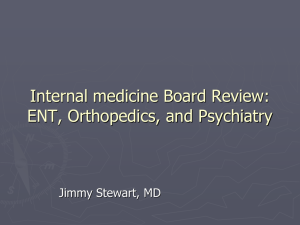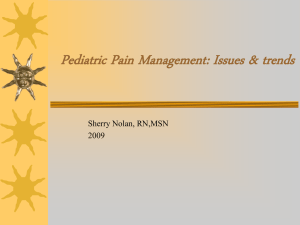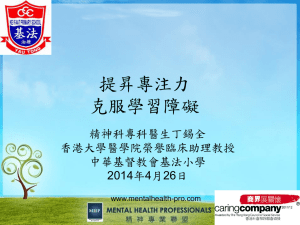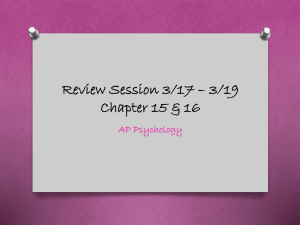Internal medicine Board Review: ENT, Orthopedics, and Psychiatry
advertisement
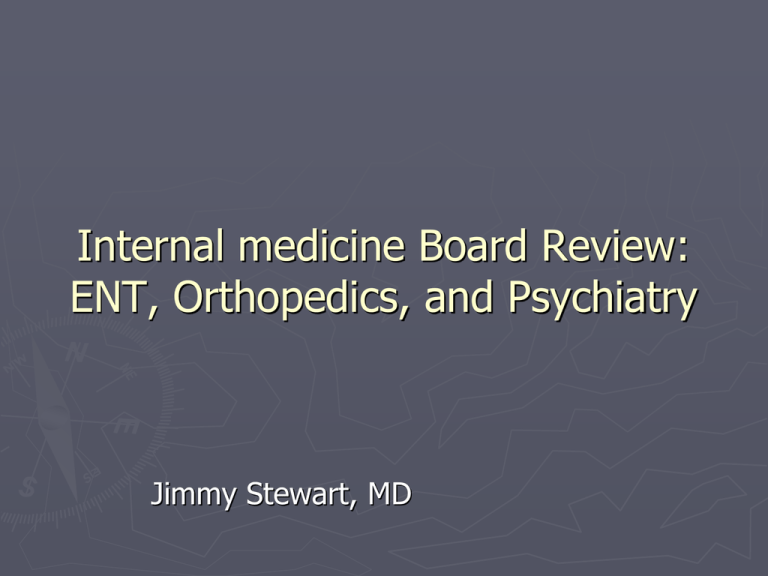
Internal medicine Board Review: ENT, Orthopedics, and Psychiatry Jimmy Stewart, MD ENT ► Common • • • • • • • • • conditions/high yield topics for the boards: Hearing Loss Tinnitus Otitis Cerumen Impaction Epistaxis Sinusitis Oral Ulcers/Cancers Pharyngitis Hoarseness Hearing Loss ► Acute vs. Chronic ► Acute (< 2 wks) • Steroids • Referral to ENT ► Causes: • • • • • • Acoustic Neuroma Meningioma Trauma Meningitis Viral or Suppurative Labyrinthitis Drugs Hearing Loss ► Unilateral ► Interpret vs. Bilateral the Weber Test: Sound should be heard equally in both ears If the sound is heard best on the side of the hearing loss—conductive. If the sound is heard best in the unaffected ear— sensorineural. Hearing Loss ► Sensorineural hearing loss • brain, • internal auditory canal • VIII Nerve or cochlea ► Presbycusis is most common—symmetric, high-frequency, hard to hear in noisy settings, 50-70 yo Hearing Loss ► Presbycusis Screening ►Whispered Voice Test ►Hearing Handicap Inventory for the Elderly ►Objective Audioscopy ► Current recs: screen with questionnaire and audioscopy every 1-3 years >55-60yo Hearing Loss ► Conductive • • • • Hearing Loss: Otitis cerumen impaction cholesteatoma otosclerosis ► Otitis - most common ► Cholesteatoma ► Otosclerosis - Surgery - Surgery Tinnitus ► Causes: • Medications (NSAID/ASA), • Labyrinthitis • Noise exposure • presbycusis • Meniere’s disease • otitis • Otosclerosis • Abnormal vascular flow • Muscular ► Unilateral or pulsating tinnitus - intracranial or vascular imaging • acoustic neuroma • jugular bulb • carotid artery abnormalities Otitis ► Otitis externa – water exposure (lake) ► Otalgia, aural d/c, decreased hearing and itching. Erythematous canal, tender with manipulation of outer ear. ► Treatment – reestablish acidic environment (acetic acid drops), topical antibiotics—neomycin plus polymyxin. ► Necrotizing otitis externa — hospitalization, iv fluoroquinolones in severe cases. Diabetics - Pseudomonas. Otitis ► Otitis ► Rx: media—much more common in children. Reserve antibiotics for purulent otitis media (opacification of TM or drainage) or refractory cases. Amoxicillin is first line, Macrolide or Clinda for PCN allergic pts. Cerumen Impaction ► Symptoms – ear fullness, conductive hearing loss, tinnitus, ear pain, pruritis. ► Mechanical or Chemical removal ► Contraindications • • • • for cerumen removal: otitis externa, history of severe otic infections history of ear surgery myringotomy tubes/perforated TM. Epistaxis ► Anterior ► Rx nose – most common –administer phenylephrine or oxymetazoline spray for vasoconstriction. Nasal packing in refractory cases. Sinusitis • • • • Acute (under 4 wks), Sub acute (4-12 wks) Chronic (over 12 wks) Most cases viral Sinusitis ► Signs • • • • • • of bacterial infection: > 7 days of symptoms Purulent nasal discharge Maxillary tooth or facial pain Abnormal transillumination Ineffectiveness of decongestants Pts improve then worsen Sinusitis ► CT Sinuses > sinus radiography. ► Treatment • • • • • antihistamines analgesics systemic or topical decongestants Topical steroids Saline wash ► Moderate evidence for antibiotics (Amoxicillin or Bactrim) for bacterial rhinosinusitis. Oral Cancer ► Men, ETOH, Tobacco ► Biopsy any ulcers that do not resolve in 4 weeks. Oral Cancer ► Leukoplakia and erythroplakia precede squamous cell carcinoma. Oral Ulcers ► Aphthous stomatitis - most common ► Recurrent aphthous stomatitis – • • • • • • HIV IBD celiac sprue Behcet’s SLE HSV (extremely painful) Acute Pharyngitis ► 90% infectious: • 50% Viral • 30% Idiopathic • 20 % Bacterial—most Group A Strep. ► Only • • • • use antibiotics when group A step is highly likely: Fever Tonsillar exudate Tender Anterior cervical lymphadenopathy Absence of cough ► Throat ► PCN cultures in pts with 3-4 criteria and a negative rapid test. x 10 days, Erythromycin in PCN allergic pts—Azithromycin or cefuroxime are similarly effective but more expensive. Acute Pharyngitis ► Infectious mononucleosis—presents with fever, LA, and exudative pharyngitis. ► How • • • • • is that different from group A Strep? Prolonged symptoms Splenomegaly—50% of cases Hepatomegaly—10% of cases Lymphocytosis Thrombocyopenia Hoarseness ► Acute—overuse vs. infection—resolves in less than 2 wks without AntiBx. ► Chronic • • • • • (>2 weeks) PND, Cancer, inhaled corticosteroids/asthma, acid reflux. Referral for direct laryngoscopy. ► Smokers or former smokers with hoarseness persisting beyond 3 weeks - direct laryngoscopy. Orthopedics ► Common • • • • • • Conditions/High Yield Topics: Low Back Pain Shoulder Pain Hand and Wrist Pain Hip Pain Knee Pain Foot and Ankle Pain Low Back Pain ► 95% of pts with disc herniation have sciatica. ► Positive ► Wasting crossed straight leg raise test. of calf muscle, weak ankle dorsiflexion are generally predictive—weak plantar flexion is highly predictive of S1 radiculopathy. Low Back Pain ► Long-term outcome - good ► In pts older than 50 yrs, an initial spine radiograph series and ESR to r/o cancer. ► Systemic Dx or history of cancer or trauma, an abnormal neuro exam, or no improvement after 2-4 wks of conservative therapy need additional evaluation. ► Cauda Equina Syndrome Low Back Pain ► Red • • • • • • • Flags Major Trauma Corticosteroid Use Age >50 yrs Unexplained Wgt Loss Fever, immunosuppression, injection drug use Saddle anesthesia, bowel/bladder incontinence Severe/Progressive neuro deficit Low Back Pain ► Imaging studies are OVERUSED!. ► MRI and electromyography are the tests of choice when the diagnosis is unclear. ► MRI tends to over-diagnose anatomic abnormalities. Low Back Pain ► NSAIDS, Acetaminophen, Muscle Relaxants. ► Tricyclic antidepressants/gabapentin/cymbalta ► GET OUT OF BED! ► Surgery may relieve symptoms in pts with an identifiable spondylolisthesis or disk herniation—pain and neurologic symptoms are similar at 1 and 5 years Shoulder Pain ► Most common • subacromial bursa • impingement. ► Other • • • • sources of pain adhesive capsulitis rupture of the rotator cuff tendon OA cervical radiculopathy ► Don’t forget about referred pain Shoulder Pain ► NSAID and rest for 2 wks. ► Subacromial corticosteroid injection ► PT ► Surgical referral when conservative measures fail. Elbow Pain ► Epicondylitis—inflammation at the extensor radii tendon on the lateral or medial epicondyle of the humerus. ► Rx: immobilization (sling) and NSAIDS for 2-3 weeks. Corticosteroid injection for recalcitrant symptoms. ► Olecranon • • • • bursitis repetitive trauma RA gout infection Wrist and Hand Pain ► Bilateral Pain • degenerative • inflammatory ► Unilateral • overuse • trauma • crystal-induced synovitis • reactive process Wrist and Hand Pain ► Psoriatic arthritis - skin findings ► Rheumatoid - PIP, MCP and wrist. Wrist and Hand Pain ► Thumb • • • • 1st Carpometacarpal deg arthritis women 30-60 Thumb splint NSAIDS ► Radius • • • De Quervains tenosynovitis Finkelstein test NSAIDS, Steroid injection Hand and Wrist Pain ► Carpal Tunnel Syndrome: • Tinel’s • Phalen’s • diabetes • hypothyroidism • Pregnancy • Splinting • NSAIDS • Referral for surgery Hip Pain ► OA, bursitis, and myofascial syndromes ► OA: Pain progresses gradually, felt in the groin, except in severe case is present when walking but not at rest. ► Internal ► Initial rotation is usually limited. therapy with NSAIDS, joint replacement Hip Pain ► Trochanteric bursitis—tender on lateral palpation, pain with walking or lying on affected side. ► Iliopsoas—pain in thigh, pelvis and groin that decreases when the hip is flexed. ► Ischial—pain ► Heat, with sitting. Massage and NSAIDS—local injection in refractory cases. Hip Pain ► Most common myofascial: ileotibial band syndrome. ► Dull ache over the lateral hip and thigh. Pain is reproduced by stretching the fascia. ► Treat ► DD: with stretching, heat, NSAIDS and +/-PT. osteonecrosis of femoral head Knee Pain ► Inflammatory • gout • pseudogout • RA • Reiter’s • infection ► Arthrocentesis essential for diagnosis. Knee Pain ► Prepatellar bursitis • frequent kneeling • Aspirate the bursa ► Patellar tendonitis • jumping sports, stair climbing • tenderness over tendinous attachment to the patella. ► Chondromalacia • • • • patellae running descending stairs lateral tracking of patella displacement and pain with extension, crepitus ► Anserine bursitis—medial tibial plateau Knee Pain ► Osteoarthritis • >55 unless there is a Hx of obesity, trauma or infection • physical therapy • NSAID • corticosteroid injection • hyaluronic acid • Joint replacement Knee Pain ► Trauma—When • • • • • to get x-rays? Ottawa rules: 55 yrs or older Isolated tenderness of the patella Tenderness at the head of the fibula Inability to flex to 90 degrees Inability to bear weight. Knee Pain ► Anterior Cruciate Ligament Tear: twisting injuries, large effusion, Lachman test/anterior drawer test. ► Collateral twisting. ligament tears occur with valgus or varus without ► Posterior cruciate tears occur with falls onto a flexed knee or force onto the anterior knee—usually associated with injury to other ligaments. ► Meniscal tears—pain, stiffness, locking, popping, need MRI to diagnose. Foot and Ankle Pain ► Ankle radiographs • Non-weight bearing • Point tenderness distal posterior medial/ lateral malleolus. ► Foot radiographs • Non-weight bearing • Point tenderness navicular or the base of the fifth metatarsal. ► Sprain treatment • RICE • wt bearing as tolerated • PT Foot and Ankle Pain ► Achilles • • • • rest NSAIDS stretching Do not inject! ► Plantar • • • • tendonitis Fasciitis Worse in the morning and after long periods of rest stretching orthotics NSAIDS Ankle and Foot Pain ► Hallus Valgus (bunion)—lateral deviation of the great toe, painful swollen bump over the head of the first metatarsal. Causes--Genetics, narrow shoe boxes, and hyperpronation. Rx: surgery for severe pain, difficulty in fitting footwear, impaired function. ► Morton’s Neuroma—fibrosis of the nerve passing between the third and fourth distal metatarsals—burning, cramping forefoot pain. Rx: broad toed shoes, pronatory insoles, and corticosteroid injections. ► Stress fractures of the metatarsals occur with a sudden increase in activity—may initially have negative radiographs and require bone scans. Psychiatry ► Common • • • • • • • • Conditions/High Yield Topics: Depression Bipolar Disorder Generalized Anxiety Disorder Panic Disorder and Panic Attacks Somatization Disorders Obsessive Compulsive Disorder Alcohol Withdrawal Eating Disorders Depression ► Criteria • • • • • • • • • ►5 for Major Depressive Episode: Depressed mood most of the day almost every day Diminished interest or pleasure Wgt loss or wgt gain Insomnia or hypersomnia Psychomotor agitation or retardation Fatigue Feelings of worthlessness or excessive guilt Diminished ability to concentrate Recurrent thoughts of death, suicidal ideation, or suicide attempt – One of which must be depressed mood or diminished interest. Sx = 2 wks. Depression ► Criteria for Dysthymic Disorder • Depressed mood for most of the day, more days than not for two years. • Presence of two or more: ►Poor appetite ►Insomnia ►Fatigue ►Low self-esteem ►Poor concentration ►Feelings of Hopelessness During the two year period the person has never been without these Sx for more than 2 months. Depression ► Treatment: • SSRI. • Tricyclics ► Frequent ► 6-9 follow up months of treatment ► Cognitive behavioral, interpersonal and problemfocused therapies are also effective with medication. Bipolar Disorder ► Screen all pts with depressive Sx for bipolar disorder. ► Bipolar ► Bipolar I—extreme swings in mood II—shorter, less severe high periods and depressive episodes. Bipolar Disorder ►Li • Monitor renal function • Sick sinus syndrome • Thyroid ►Divalproex Generalized Anxiety Disorder ► Worry or concern disproportionate to the likelihood of the feared event. DSM IV: • Excessive worry x6 months • Worry is pervasive and difficult to control • Three of these Sx: ►“On edge” ►Easily tired ►Concentration difficulty ►Irritability ►Muscle tension ►Sleep disturbance Generalized Anxiety Disorder ► Limit caffeine use ► relaxation ► treat techniques coexisting psychiatric diagnoses. ► SSRI/norepinephrine reuptake inhibitors ► Tricyclics ► Benzodiazepines—preferably long acting. Panic Attacks/Panic Disorder ► Intense, unexpected episodes of terror and fear accompanied by somatic symptoms. ► Pts with prolonged apprehension and/or avoidance behavior have panic disorder. ► Very often associated with major depression—when associated has a much higher rate of suicide. Panic Attacks/Panic Disorder ► For pts with infrequent attacks and no avoidance— education and relaxation techniques. ► Phobic avoidance—cognitive behavioral therapy or medication. ► Medications—SSRI reuptake inhibitors ► Benzodiazepines or selective norepinephrine in severe cases. Somatization Disorder ► Almost never the right answer on the test! Obsessive Compulsive Disorder ►High dose SSRI Alcohol Withdrawal ► Minor withdrawal symptoms—insomnia, tachycardia, tremor, headache, and GI upset. ► Major withdrawal symptoms—seizures, hallucinations, and delirium tremens. Alcohol Withdrawal ► Minor symptoms begin within 6-12 hours of alcohol cessation and usually resolve within 48 hours. ► Delirium tremens—disorientation, hallucinations, hypertension, agitation and tremor. Usually begins several days after last alcohol use and persists for up to 5 days. Alcohol Withdrawal ► Risk factors for severe withdrawal—Hx of severe withdrawal, chronic alcohol use, age over 30 yrs, and presence of a significant concurrent illness. ► Treatment—supportive: Thiamine/Folate, electrolyte supplementation. ► Benzodiazepines improve withdrawal symptoms and decrease the incidence of seizure and DTs. Lorazepam in pts with known hepatic disease. Symptom triggered dosing reduces duration and total amount of medication. Eating Disorders ► Bulimia—pattern of binge eating with associated purging—self induced vomiting, laxative and diuretic abuse. Dysmorphic body image. ► Anorexia—Refusal to maintain normal body weight, fear of wgt gain, severe body image disturbance, amenorrhea. Eating Disorders ► Treatment involves interdisciplinary teams— internist, psychiatrist, and nutritionist. ► Cognitive behavioral therapy is helpful—more so for bulimia. ► Pharmacotherapy is less helpful—be sure to treat underlying co morbid conditions (OCD and depression) The End! Good Luck.
